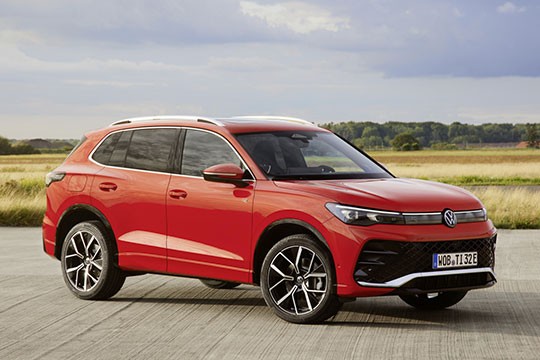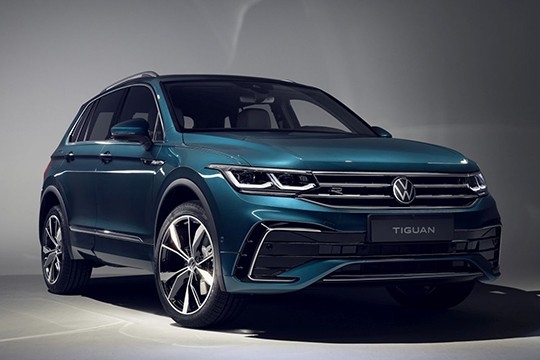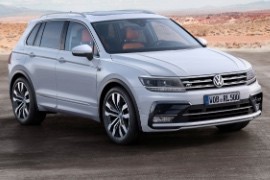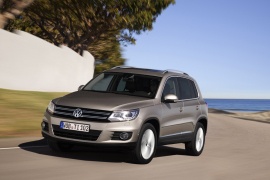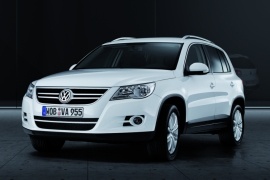VOLKSWAGEN Tiguan Models/Series Timeline, Specifications & Photos
First production year: 2008
Engines: Mild hybrid, Diesel, Gasoline
Body style: SUV (Sports Utility Vehicle)
Volkswagen introduced the third generation of its compact SUV, Tiguan, in 2023, and it was a big step forward for the vehicle compared to its predecessor in terms of styling, technology, and features.
The Tiguan started its career trying to catch up with Nissan Qashqai and losing most of the time. Volkswagen didn’t have the reputation of a 4x4 car maker, so its products suffered in that segment. But the German automaker didn’t give up and pushed harder on the market. The second generation, which it launched in 2016, performed better and took the crown as the best-selling VW. By 2023, the Tiguan had reached 7.6 million units sold and was on its way to success. That’s why its creator tried to make a better car and surprise its customers in a good way.
With styling cues carried over from its bigger brother, the Touareg, the Tiguan looked more up-scale than its predecessor. Strangely, there was no grille above the massive bumper, just a lower one needed to cool the engine and a pair of side scoops that housed a pair of air intakes. The LED headlights showed a new, more angular design than on the Tiguan’s second generation and flanked a strip that supported the carmaker’s badge. From its profile, the compact SUV revealed its sculptured doors and the widened rear quarter panels, creating a muscular image for the Tiguan. Finally, at the back, the tilted forward tailgate sported a roof spoiler. Also, at the back, customers could notice the lack of any exhaust, not even fake ones. For the sporty version, Volkswagen added piano-black trims at the front bumper, the B- and C-pillars, and the rear bumper.
Inside, the third generation of the Tiguan boasted a more luxurious cabin than its predecessor. It now featured a standard 10” instrument cluster and up to 15” touchscreen for the infotainment system. Just like the rest of the Volkswagen range, the multimedia unit didn’t feature a dedicated volume knob, but the automaker thought slightly differently. Volkswagen listened to its clients and ditched the touch-buttons from the steering wheel and replaced them with physical ones, which was a good thing. Between the front seats on the center console, it installed a rotary dial with its own touch-button inside that could control several systems, including the volume. The front occupants could access it from their comfortable seats designed for long journeys. In the back, the carmaker installed a split-folding bench seat that could expand the 652-liter (23 cu-ft.) trunk.
Volkswagen built the Tiguan on the MQB evo platform and installed a choice of hybrid, gasoline, or diesel drivetrains. All of them were prepared for the Euro 7 emission standards and provided not just good performance but also low fuel consumption figures. Furthermore, the 2023 iteration of the Tiguan was the first to completely ditch the manual gearboxes and featured just dual-clutch ones for the entire range.
With a lot of experience under its belt regarding performance vehicles, Volkswagen introduced the most potent version of its Golf-based Tiguan model, the R.
Along with the 2020 facelifted version, Volkswagen introduced a new model in the stable: the wild Tiguan R. A 320 hp compact SUV that was able to run among the best hot-hatches on the road and still be able to cope with some mild off-road situations.
On the outside, the broad black grille on the front bumper accompanied the same color grille. The new styling of the headlights resembled those installed on the Golf VIII. On the sides, the silver caps on the door-mirrors with LED turn-signals were specific for the Tiguan R. At the rear, the “R” lettering was installed in the middle of the tailgate, under the VW badge. In order to open the trunk, a hands-free system was fitted as standard. The roof-spoiler on top of the tailgate emphasized the sporty character of the car. Last but not least, the quad-exhaust system was specifically designed for the Tiguan R.
Inside, the designers installed top features never seen before on a Tiguan. The steering wheel featured illuminated touch islands and sliders. A new touch-module was installed for the climate control unit and for the heated front seats. A set of Type C USB ports were placed on the center stack. The Tiguan R was fitted as standard with an 8” screen for the Volkswagen Digital Cockpit.
Power came from a turbocharged direct-injection engine that offered 320 hp. The 2.0-liter engine was paired as standard to an 8-speed automatic transmission that sends the power in all four corners via a torque-vectoring system.
The second generation of the Volkswagen Tiguan was shown at the 2015 Frankfurt Motorshow and it is the answer given by the German car manufacturer to the compact crossover segment.
In 2016, basically, every car-manufacturer had something to say on the compact SUV segment. Considering this, the German manufacturer has decided not to improve the first generation but rather transform it and started from scratch.
The second Tiguan platform was the MQB, which was used for the first time for an SUV. The width of the vehicle was aesthetically enlarged due to its grille with two horizontal chromed lines on it and narrow headlights. Unlike the previous generation, the 2016 Tiguan didn't look just like a modified hatch-back. It had a proper SUV image, even in the long-wheelbase version that could host up to seven people inside.
Inside, the clean dashboard and simple lines were typical for a Volkswagen. It didn't have something special on the look, other than being very practical. Everything was exactly where you'd expect to be, but somehow boring. The infotainment system offered an option for an 8” touchscreen display and it could connect to Android Auto and Apple CarPlay. The rear seats could have been moved back and forth, with a reclining seatback.
For the engine compartment, the Tiguan had plenty of engines to offer, including a 2.0-TDI engine that featured different power levels, from 150 hp up to 250 hp on the R-version. The Tiguan was offered either with 2WD or all-wheel-drive.
Somewhere between luxury and mainstream, the Volkswagen Tiguan compromised some of its practicality for a top-notch cabin.
While the typical compact crossovers’ interiors were fitted with lots of plastics, the Tiguan managed to eclipse the competition by providing high quality materials approaching those of premium brands.
Minor updates were brought to the exterior and the most notable was the redesigned front grille.
The compact crossover was available in three trim levels: S, SE and SEL.
Offered with a standard front-wheel-drive system, the SE and SEL could be chosen with a 4wheel-drive system, Volkswagen’s 4Motion.
While the base trim level included 15-inch alloys, air-conditioning, cruise control, keyless entry, Bluetooth connectivity and an 8-speaker audio system, the SE added larger 17-inch alloys, chrome exterior details, fog lights, a roof rack, a multifunction steering wheel, heated front seats, leatherette upholstery and a roof storage console.
The top-of-the-range included adaptive bi-xenon headlights, rain-sensing wipers, ambient interior lighting, keyless go, leather upholstery, automatic climate control, 18-inch alloys, a panoramic sunroof and a navigation system.
Several other options were bundled into packages and some of them were offered as stand-alone options such as side steps, 19-inch alloys, a trailer hitch and a different body kit.
Standard safety features included antilock disc brakes, stability control, traction control, front-seat side airbags and side curtain airbags.
VOLKSWAGEN Tiguan 1.4L TSI 4MOTION 6MT AWD (160 HP)
VOLKSWAGEN Tiguan 1.4L TSI FWD 6AT (160 HP)
VOLKSWAGEN Tiguan 1.4L TSI FWD 6MT (122 HP)
VOLKSWAGEN Tiguan 1.4L TSI FWD 6MT (160 HP)
VOLKSWAGEN Tiguan 2.0L TSI 4MOTION 6AT AWD (200 HP)
VOLKSWAGEN Tiguan 2.0L TSI 4MOTION 6MT (210 HP)
VOLKSWAGEN Tiguan 2.0L TSI 4MOTION 6MT AWD (180 HP)
VOLKSWAGEN Tiguan 2.0L TSI 4MOTION 7AT AWD (180 HP)
VOLKSWAGEN Tiguan 2.0L TSI 4MOTION 7AT AWD (210 HP)
VOLKSWAGEN Tiguan 2.0L TDI 4MOTION 6MT AWD (140 HP)
VOLKSWAGEN Tiguan 2.0L TDI 4MOTION 6MT AWD (170 HP)
VOLKSWAGEN Tiguan 2.0L TDI 4MOTION 7AT (177 HP)
VOLKSWAGEN Tiguan 2.0L TDI 4MOTION 7AT (184 HP)
VOLKSWAGEN Tiguan 2.0L TDI 4MOTION 7AT AWD (140 HP)
VOLKSWAGEN Tiguan 2.0L TDI 4MOTION 7AT AWD (150 HP)
VOLKSWAGEN Tiguan 2.0L TDI BlueMotion FWD 6MT (140 HP)
VOLKSWAGEN Tiguan 2.0L TDI FWD 6MT (110 HP)
Due to the high demand for SUV vehicles, Volkswagen launched the compact-sized Tiguan in the autumn of 2007, at the Frankfurt Motor Show. And it was a huge success.
Despite the fact that the world surged into an economic crisis soon after the Frankfurt Motor Show, the Tiguan was well received by the market. While some considered it as the little brother of the Touareg, the Tiguan was more of a bigger brother of the Passat B6. It shared the same platform with the Passat CC.
The Tiguan featured a simple, yet honest, design. It looked more like a hatchback on stilts than an SUV, but it worked. The front overhang was quite long for an SUV, but it was needed to install the engine accessories. The headlights resembled those fitted on the Passat CC. The A-pillars were not very raked, to enhance the rugged image of the car. In the rear, the widened fenders were unusual for an SUV, but more commonly found on a sporty hatchback.
Inside, there were many similarities with the Golf V but technologically evolved. The top infotainment unit, (RNS510) offered a standard 30 Gb hard disk memory for maps, music, and even pictures. A panoramic roof was offered as an option.
The 2008 Tiguan was offered exclusively with turbocharged engines, either gasoline or diesel. The latter proved to be part of the Dieselgate scandal, even though they were marketed as Euro 5 engines.
VOLKSWAGEN Tiguan 1.4L TSI 4MOTION 6MT AWD (150 HP)
VOLKSWAGEN Tiguan 1.4L TSI 6MT AWD (122 HP)
VOLKSWAGEN Tiguan 1.4L TSI 6MT AWD (150 HP)
VOLKSWAGEN Tiguan 2.0 TFSI 4MOTION 6MT AWD (200 HP)
VOLKSWAGEN Tiguan 2.0L TFSI 4MOTION 6AT AWD (170 HP)
